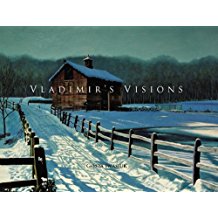Recently, I came across of a unique book.
This work is a tribute by Dr. Gosta Iwasiuk to his father Vladimir. It’s an anthology of the works of a person, who created a magnificent body of paintings and sculptures. In his spare time, he was also a physician.
Born just before WW1 started, Vladimir went through the horrors of the enormous military conflict, not knowing that in a few years later, he, and his young family, will have to be dragged through the savagery of yet another struggle, initiated by a monster born in their own neck of the woods. The riches of Vladimir’s artistic creations are examples of the versatility of his mind and the dexterity of his hands. Vladimir traveled, not always by choice, throughout the Europe, and the United States and his topics include landscapes and people from all the visited areas. I am moved by the artistic value of the works, amazed by the technique, and humbled by the humanism of his art. The body of work is enormous, and I can hardly imagine how in the world Vladimir could find the time for his main calling, which was taking care of his patients.
Throughout the history, there were many physicians having also artistic interests. St Luke, one of the Evangelist, I was amazed to find, was an artist and a physician himself. And, rightly so, became a patron-saint of both callings.
Vladimir portrayed Einstein, who played the violin, and also Schweitzer, whom it’s easier to describe, what he wasn’t interested in. But the examples of artists, who were physicians, and physicians who were the artists, were many. Copernicus was a physician and also a painter; his auto portrait may look as a source for a famous Thorvaldsen’s monument of the astronomer, standing in Warsaw. Borodin was a surgeon in a military hospital. Schiller was a regimental doctor in Stuttgart, and Keats trained as a surgeon and the apothecary.
In history, there are many doctors, who were good, and some exceptional, painters. The Dutchman Jacob van Ruisdael, known for his countryside landscapes, was also a surgeon, and his paintings are probably known the best. There were two Frenchmen: Paul Louis Collin, who was a physician and a painter, and Frederic Estre, who was a psychiatrist and a painter and worked out of a psychiatric asylum. In Russia, Boris Pasternak’s father, Leonid, was a physician and a respectable portraitist. In the United States, Francis Orray Ticknor painted while working at the Confederate Hospital in Columbus in Georgia.
But I couldn’t find any traces of father and son duos, both physicians, both painters, as it had happened in the Vladimir and Gosta Iwasiuk family.
The book by Gosta puts the works of his father in a rich historical, cultural and personal perspective. A renaissance man himself, Iwasiuk – son describes the actual milieu in which each of the pieces was created; be it a historical context, the geography of the area, and the people portrayed, coming up with many personal events, which make his father’s art alive. I greatly value the story behind the art piece and its provenance, as a priceless complement to the work. The context always magnifies the artistic impression, and, knowing how the work was created, helps me discover many more layers, not perceived by a random and casual observer.
The book is as deep as it is rich. It’s not for a casual reader. Particularly for the people in the time of Facebook’s attention span. But it does test, and improves, your knowledge of world history, and the history of arts, from the antiquity to the very recent times.
This is an impressive tribute and a priceless gift any father can receive from his son.
And Gosta Iwasiuk is, besides being the obvious choice, the best person to write it.


